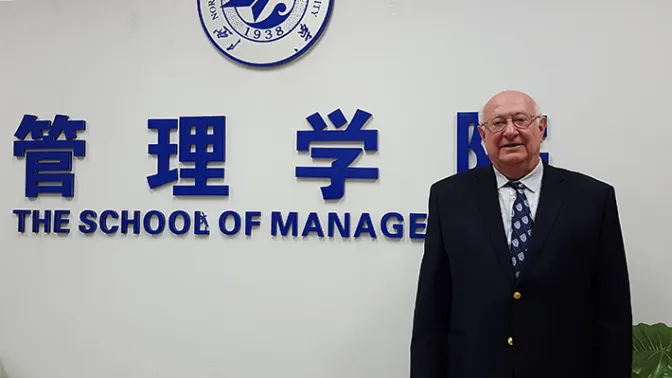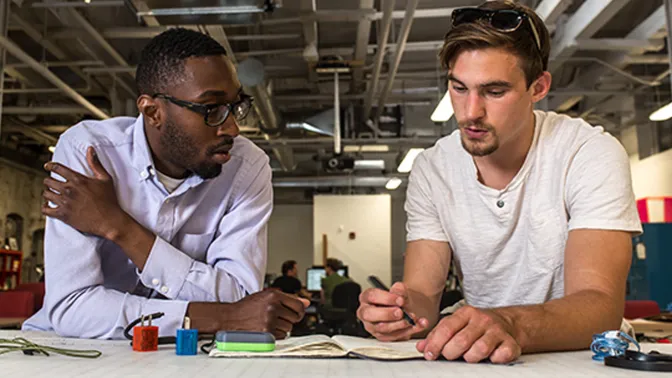
From Catch to Finish
On this breezy autumn day, 16 men and women, LeBow College’s Executive MBA class, proven leaders with biographies as diverse as the mottled leaves lining Kelly Drive, have convened to learn a skill that they haven’t encountered in their corner offices. Today, they will learn to row.
Among the group is a software architect, a senior management consultant, a director, a managing partner, a president, a vice president, a CEO and a retiring Aviation Branch Lieutenant Colonel in the United States Army. There is a senior structural architect, a director of enterprise infrastructure services for a prominent university, an internal auditor and a structural engineer. They come from Big Pharma, Big Energy, Big Education and major engineering firms. Their collective curricula vitae read like a corporate all-star line-up.
“Rowing is perhaps the ultimate team sport. Strength is subservient to synchronicity. Rhythm trumps force.”
Together for the first time, this new EMBA class is pensive, perhaps uncomfortable — not to say that the students don’t display confidence commensurate with their level of achievement, but rather that they are all too aware of the smoke and mirrors. This isn’t their first trip to the executive coach. In fact, some of them are executive coaches. They pace the gilded-mahogany grand room where the day’s lectures will play out and introduce themselves with wide, restless smiles — falling back on trusted corporate charisma to propel them through this awkward beginning.
Today is day one. There will be approximately 600 more days; 20 months of intense academic horizon that will be informed not just by lectures and lessons, but by the implications of international recession, political policy and shifting business models. Not to mention the rigorous teamwork that is the hallmark of LeBow’s EMBA program. But for now, slates are clean and coursework is tomorrow’s certainty.
Today isn’t about proving leadership. These people are well past that. Today is about finding flow. And as the sun peeks through the thinning fog, it’s time to learn to row.
Enter facilitator Dan Lyons, an accomplished competitor who has won two world bronze medals, a world gold medal and a Pan American gold medal. Lyons, a former Drexel rowing coach who holds degrees from the U.S. Naval Academy and Oxford University, is here with his crew, Team Concepts, Inc., to orchestrate today’s “team-building” activities. He smirks as the group slowly begins to assemble, sitting on foldable metal chairs arranged in familiar instructional rows. Later in the day, Lyons will admit that the apprehension is normal — that he expects it, even values it as a necessary step in the process. “We have done this program with CEOs of Fortune 500 companies, all the way down to sales teams from every industry, from government to nonprofit, to corporate to sports,” he says. “It’s all the same.
“They have to get over their own ego,” he continues. “And they’re afraid, and they want to feel valued. What we try to do is make them understand that being valued is the whole touchy-feely part of this.”
From the onset, there are indicators that the workshop will dig miles deeper than typical kumbaya trust falls and Myers-Briggs fare. Teambuilding and leadership are one and the same, he says. The exercise is a psychological study in harnessing internal synchronicity and applying it at the organizational level. It’s about committing wholly, spiritually, to a goal and helping others do the same. It’s about creating and maintaining high-performance teams. It’s emotional. It’s not just business; it’s personal. And it all ends with a race.
Lyons, whose lanky frame belies his skill with an oar, is high-energy and speaks impressively of solutions, synergies and positive attitudes. The objective, he says, it to fashion simplicity from complexity, to keep focus and drive. He talks about spirit and inspiration as if at the pulpit. His eyes pierce. He talks with his fingers, which are long and muscular. He is magnetic and heads turn when he talks.
“We have to understand that it’s important to know where we are going and commit our energy. There always has to be a process, but it is spirit that wins races,” he says.
Lyons divides the EMBA students into four teams of four— red, blue, green and gray — and the excitement is palpable. Colored hats and shirts are distributed: the first sparkles of coalescence. The students (although calling them students sounds wrong, like calling lions cats) draw their chairs closer and pull on their “EMBA Crew” shirts with pride. This isn’t what they expected.
Lyons explains that each group will train to row together, and the day will culminate with a ceremony where gold medals will be awarded. This draws smiles and shrugs. However, what is clear to Lyons and to LeBow staff hanging low at the back of the room — including EMBA Program Executive Director Charlotta Thunander, who plans this annual event — is that this isn’t a one-shot deal. These teams will remain cohorted for the entirety of the EMBA program — a reality that at first doesn’t quite sink in (and how can it, really?)
“The body language of the students before and after this experience is night and day,” says Thunander, who directs the EMBA program. “When they come to campus tomorrow, they’ll be patting each other on the back.”
Thunander, who has worked closely with EMBAs for six years, says today’s exercise is like a first look through a pinhole at a solar eclipse.
“The Executive MBA program starts out with the foundation courses to get everyone on the same page,” she says. “Then we move on to some of the core courses, which become even more challenging. And then during the second half of the program they’re challenged to really apply everything that they have learned to think strategically. It sort of connects the dots. And this day is a good example of that.”
But for now, it’s time to hit the water.
Rowing is perhaps the ultimate team sport. Strength is subservient to synchronicity. Rhythm trumps force. It is an art, really, and its application as allegory is too obvious to ignore.
First, there is the oar: 12.5 inches of carbon fiber that each rower must hold close, knuckles pointing out, ever mindful of maintaining a perpendicular plane as it breaks the water. There is also the deliberate posture and progression of a stroke, from the catch (where the oar enters the water) to the finish (where the oar is removed). Stance is crucial: Firm lower back; relaxed stomach; hands down and away; elbows out; head up; break at the knees; stretch from the lats; drive your legs against the foot stretchers; and lean back to finish as you pull inward to your core. This all must be done in synchronization with the teammates to your fore and rear. Sound hard? It is.
Each team enters an eight-man boat (or shell) with four experienced rowers for support. A coach trails each shell on a motorboat to provide individual instruction. In all, eight boats scatter beneath the Girard Avenue Bridge into instructional cabals. Constant calls of “catch” and “finish” resonate beneath the overpass.
The coaching is relentless. Each member is scrutinized, almost to the point of embarrassment. It’s not hostile; it’s necessary. For a bunch of men and women who lead for a living, the physical act of being led themselves draws out their determination. At first their faces are drawn, reserved. Next, brows stiffen in concentration. They do not want to fail.
This continues for more than an hour, during which each team’s focus is found, lost and found again in sweeps of perfection where four oars pierce water with such flawless synergy that they form two undiluted lines that connect in a “V” at the bow. It’s a striking sight and the EMBAs nod with satisfaction and pat each other on the back when they get it right. Soon, the shouting stops. Each teammate begins to follow the ebb of the oar to his fore. A powerful calm pervades. They’re getting this rowing thing.
Back at the Barge Club, while lunch is served in preparation for the final races, the group is treated to a speech from Daniel Beery, who won the gold (and set a then-world record) at the 2004 Olympic Games in Athens. Beery looks like an athlete: tall, broad and composed — the kind of rower who could dominate with muscle alone. While he speaks, Lyons sits among the group, his arms folded. He’ll be the first to admit that Beery is the most accomplished rower in the room (and in fact he does — twice). Like the rest of Lyons’ itinerary, allowing Beery, the champion, to speak before the big payoff is calculated, necessary. Lyons may be in charge, but Beery won the Olympic gold.
Despite being the most laurelled athlete in the room, Beery is clearly the least qualified orator. While he speaks of his love of the water and how it inspires him daily — even now that his competing career has ended — he frequently looks to Lyons for traces of approval, which he receives with hand gestures and attentive glances. This part is important. Beery, who competed with such precision on water, yet stumbles so endearingly while summoning the words to inspire, is Lyons’ symbolic coup de grace. Although his delivery is cautious, his message is profound.
“Control is an illusion,” Beery says. “You can’t overpower. The only thing you can do to help any situation is communicate. I call it FPC: Forced Positive Communication.”
During each race, which extends from past the Girard Avenue Bridge back to the Pennsylvania Barge Club, the teams-in-waiting cheer on their peers from the shoreline. Some stand beneath a conspicuous bronze statue of the Viking explorer Thorfinn Karlsefni, known in the epic saga of Eric the Red as one of the first Vikings to establish a settlement in North America: a man who, fittingly, led a group of 200 from Iceland across uncontrollable waters to North America. It is believed that his son was the first child of European descent born on this continent.
But here, now, on the water, LeBow’s latest batch of EMBA hopefuls is focused on making simplicity from complexity. Creating focus, flow. From the shore you can hear chants of “catch” and “finish.” And as the final bow passes the salient where the Viking statue glares, the cheers are sincere and the teams have unified around a common goal: being a team.
Later, after the thoughtfully contrived and well-received award ceremony, the EMBAs, donning their mock medals, are flushed and wet. It’s not so important who won (although, for the record, blue and red were the victors in their respective heats). They’re too busy congratulating each other, communicating. And here lies the irony. These are Executive MBA students. Company presidents. CEOs. Leaders. These men and women are results-driven, ambitious competitors. They came to Drexel, to LeBow, to win. But in Lyons’ final question-and-answer session, the touchy-feely one he warned about, most responses are surprisingly selfless. If winning was the objective, it’s clear that teamwork was the prize.
“My biggest fear was throwing everybody else off,” says Dennis Paris, president of marketing consulting firm Tangerine Strategies.
“You don’t want to embarrass yourself or let anyone down in the boat,” adds Tate Rice, vice president of operations and clinical development for Aquahab Physical Therapy. “Knowing it’s going to take some time to get the rhythm and technique in synch with that person in front of me.”
“In rowing, it’s all about catch and finish,” Lyons says. “Be at the catch together and be at the finish together.”
The newly minted EMBA rowing team can certainly count on that.



